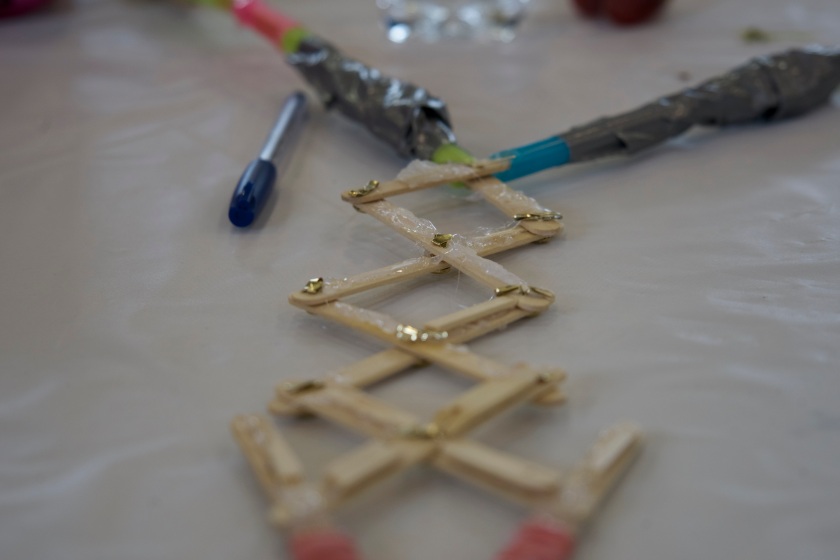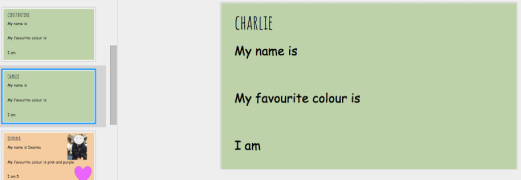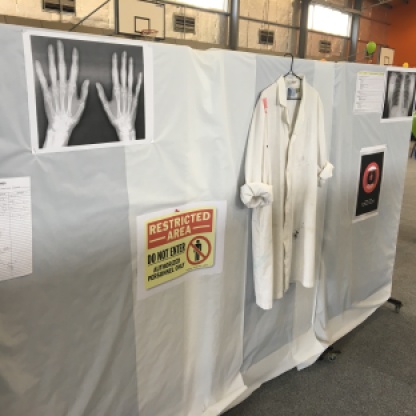In 2016, two of my colleagues worked together to hold an Interschool STEM Day, to encourage local Year 6 students to work in teams to create a solution to a problem.
Using resources from the IET Faraday website, they adapted and orchestrated a mammoth day for the students to build a device to move one litre of water from the Stadium floor, into a bucket which sat on a platform. It was a challenge designed around pumps, water wheels and water pressure.
This year, one of my colleagues was on paternity leave, so I stepped in to help his teammate. Together, Jodie and I researched a new challenge for the day based around medical engineering – build a device to conduct a remote operation to pick up a ‘kidney’ and a ‘heart’ and place them in the correct place on the body.
We had 75 students from 12 different school register, 24 teams in total. The ideal team number was 3, however a few schools only had 4 Year 6 students in total, which we allowed. The stadium was set up with medical themed decorations, x-rays, lab coats, and medicinal charts. There were ‘Research Stations’, with laptops playing videos on loop with ideas and strategies that may give students inspiration. A hot glue gun station was set up, as was our STEM shop, where all of the building materials for the day were ready to be purchased by the teams.
The day started with a video about medical engineering to put the day into context, how operating theatres rely on robotics and other technology to assist them in procedures. Students were asked to sketch in their Challenge Workbooks a way to move an object from one place to another without physically touching it with their body. We introduced the ideas of forces – push/pull, levers, scoops, suction etc.
Each team was given a budget of $150 STEM dollars. They were required to plan their design, keeping their budget in mind. They were to assign roles to each group member and also create a ‘Learning Log’ using an assigned iPad, to create a documentary-style video of their manufacturing process.
Our school Kitchen Garden coordinator provided us with lunch and students received a small show bag with water and snacks for recess and their workbooks. We operated on a continual scoring system using Google Sheets so that both of us organisers could access to add scores and annotations throughout the day. Students received scores for their design briefs, their sketches, accuracy of their account balance ledger, effectiveness of their design and their teamwork skills.
After lunch, students packed up their tables and we sat down to perform 24 mock heart (ping pong ball) and kidney (ping pong ball) transplants. An iPad was placed above the operating table, where our cardboard cutout body and his foil tray organ chambers lay waiting. This iPad was to live-stream the action on the table, not just for the audience, but for the ‘surgeon’ operating the device. Just like in an operating theatre, the surgeon would be using the large screen to guide his actions while his vision to the cardboard body was blocked by a curtain.
Students had to work around certain parameters – the device must be able to reach a distance of 50cm, it must be able to pick up and drop objects accurately and both heart and kidney must be transplanted in just 90 seconds – it’s life or death for our cardboard body!!

The winning team was gifted with a set of 6 Makey Makey kits to take back to their school to encourage creative and critical thinking to assist on their STEM journey!
There were many different designs – some more successful than others. There were many levels of teamwork and many different conversations that filled the stadium. The teachers who accompanied the teams from their school were pleased to see such collaboration and skill – not just for those students who excelled in the classroom.
Go Team STEM!















